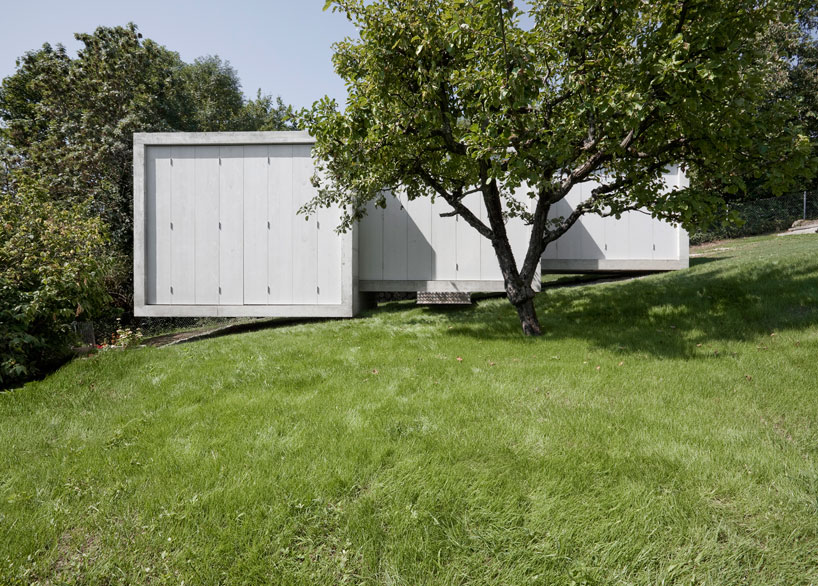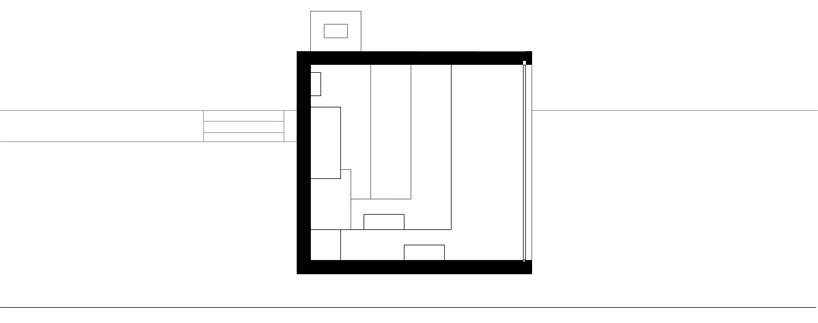| studio velocity: little one room house with a curve From designboom 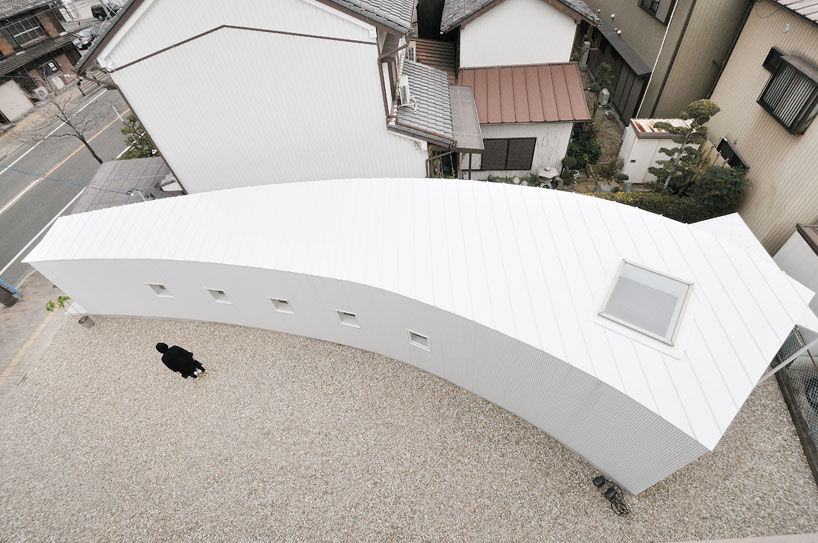 'little one-room house with a curve' by studio velocity in nagoya city, japan all images courtesy studio velocity 'little one-room house with a curve' by japanese architects studio velocity is a 41 m2 hair salon in nagoya city. placed on an elongated site measuring 9 m by 20 m, the design explores multiple curvatures in its form to achieve a continuous space that gradually changes as one walks though it.  view from above one of the primary concerns with building on such a small plot was to avoid designing a structure that 'disappeared' from the more dominant scale of the surrounding houses. by adopting an unconventional form to the single-storey shop, the project was given an individual identity that secured its presence in the neighbourhood.  street view making the most out the narrow site, a small parking area for 2 cars is reserved near the front of the plot. to accommodate this, the tapered end of the building starts near the street and gradually widens in both its width and height as it nears the rear of the ground. an outdoor garden is nestled in the curve of the design, creating a private space of reflection that can be viewed from inside the shop. concealed behind the building is a washing space which provides a place for hanging laundry. 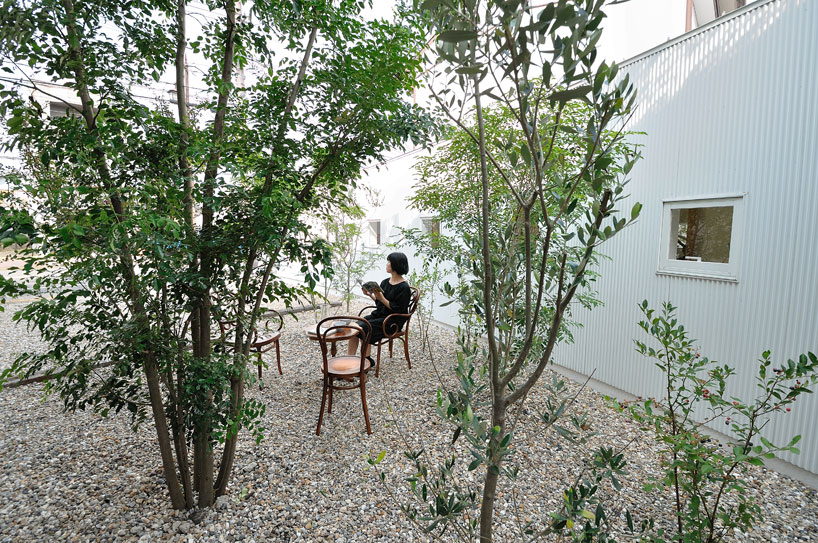 outdoor garden in designing the specific curve of the salon, an extensive study of the overall balance of the interior space was conducted to maintain an effortless view throughout the salon. defined in sections, the entrance leads into a small waiting room and reception that leads to the cup and shampoo space. a long hallway is rhythmically pierced with small windows to the garden, providing ample daylight into the interior. in addition, a large skylight at the height of the vertical curve washes down the ceiling and surfaces above the work area.  entrance  view of salon space  curved hallway  views of reception space  site   program placement on site  floor plan 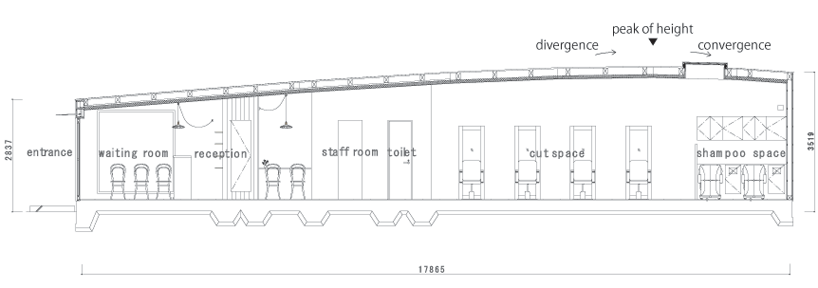 longitudinal section 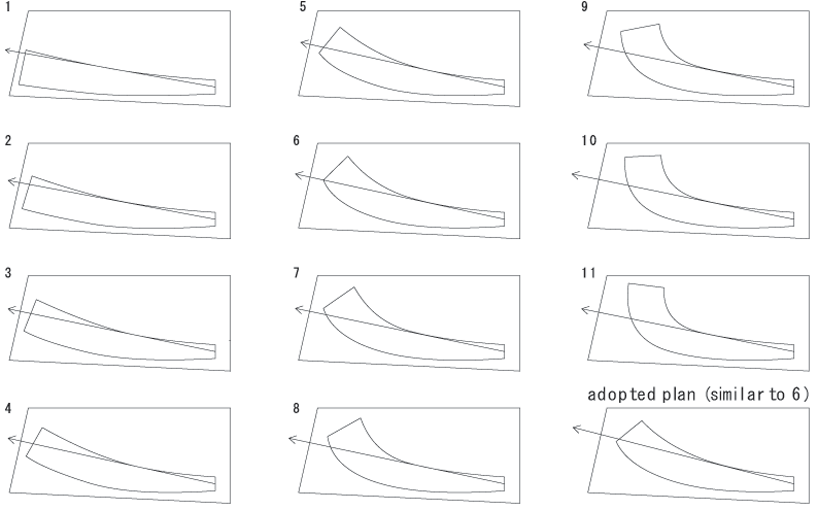 process diagram |
Houses I Like
Saturday, April 16, 2011
Hair salon...
Tuesday, April 5, 2011
These Glowing Glass Boxes Are Minimalist Guest Cottages in the Forest Read more: Minimalist Dry Creek Guest Cottages Glow Like Two Lanterns in the Forest | Inhabitat - Green Design Will Save the World
From Habitat.com
It's 1am and you've been on the road for hours when two beacons of light pierce through the darkness telling you that a warm bed awaits - in fact, you can even see it (fluffy pillows and all) through a stylish wall of glass. That's the soothing scene that awaits weary travelers who make these minimalist guest cottages in Woodside, CA their destination. Called the Dry Creek Outbuildings, these modest structures by Bohlin Cywinski Jackson were built from sustainable Western Red Cedar and beckon visitors like illuminated lanterns in the forest.
The outbuildings, though we hate to call them that because they are so much more, comprise a cottage and an office that were erected to replace the decrepit existing buildings that once stood in their place. Western Red Cedar, a sustainable material that had the lowest environmental impact when weighed against other material choices, line theboxes, and is just one of the eco considerations that contributed to the houses winning the 2010 Green GOOD DESIGN awards.
“They sit at the edge of a creek between the public world of the entry drive and the secluded forested creek,” describe the architects. “Western Red Cedar clad boxes, constructed with the precision and thoughtfulness of a cabinet, face the entry drive while more private glazed living areas open up to the creek. The weathered cedar boxes contain the ‘service’ elements of the program: a galley kitchen, bathrooms, an office and utility rooms. Delicate ribbon windows are strategically placed in the simple façades providing specific views, introducing light, and maintaining privacy where required.”
The same warm cedar is used on the interior as well, translating the rustic language of the outside world and softening it to make sense indoors. From inside the boxes, guests still have an almost unobstructed view of the great oaks and moss covered rocks of the babbling creek. When night falls, the large lanterns light up with the moon adding a gentle glow to the forest.
B. C. Jackson








It's 1am and you've been on the road for hours when two beacons of light pierce through the darkness telling you that a warm bed awaits - in fact, you can even see it (fluffy pillows and all) through a stylish wall of glass. That's the soothing scene that awaits weary travelers who make these minimalist guest cottages in Woodside, CA their destination. Called the Dry Creek Outbuildings, these modest structures by Bohlin Cywinski Jackson were built from sustainable Western Red Cedar and beckon visitors like illuminated lanterns in the forest.
The outbuildings, though we hate to call them that because they are so much more, comprise a cottage and an office that were erected to replace the decrepit existing buildings that once stood in their place. Western Red Cedar, a sustainable material that had the lowest environmental impact when weighed against other material choices, line theboxes, and is just one of the eco considerations that contributed to the houses winning the 2010 Green GOOD DESIGN awards.
“They sit at the edge of a creek between the public world of the entry drive and the secluded forested creek,” describe the architects. “Western Red Cedar clad boxes, constructed with the precision and thoughtfulness of a cabinet, face the entry drive while more private glazed living areas open up to the creek. The weathered cedar boxes contain the ‘service’ elements of the program: a galley kitchen, bathrooms, an office and utility rooms. Delicate ribbon windows are strategically placed in the simple façades providing specific views, introducing light, and maintaining privacy where required.”
The same warm cedar is used on the interior as well, translating the rustic language of the outside world and softening it to make sense indoors. From inside the boxes, guests still have an almost unobstructed view of the great oaks and moss covered rocks of the babbling creek. When night falls, the large lanterns light up with the moon adding a gentle glow to the forest.
B. C. Jackson








Wednesday, March 30, 2011
La Casa del Campo
de mi amiga Manuela





Weekend residence in the pampas of Argentina
Built with traditional methods, noble materials and a limited budget, this contemporary design culminates a 20 year dream of a family of artists. Flexibility was key for the changing demands of the project. Activities vary from reading, painting, exhibiting art, and gathering around the fireplace in the built in lay beds which accommodate spontaneous guests.
The asymmetry of it's 25 windows frames thousands of views of the Argentine pampas. Multiple vistas arouse curiosity, contemplation and motion, like paintings coming alive or screens capturing the changes of light and time; the harvesting of the crops, the deepness of the horizon and the ancient ombu tree. Space experimentation is vital for the concept of this L shaped house, its different volumes with changing ceiling heights create different atmospheres.
Sustainability was also important to his project implemented by the use of local materials, natural illumination, cross ventilation which allows natural breeze to flow. The design was developed in Chicago by Manuela Garcia Faure Architecture with technical documentation, contract administration and site inspection by Architect Lorenzo in Buenos Aires.





Un quincho para el jardin, divine!
|
Subscribe to:
Posts (Atom)




